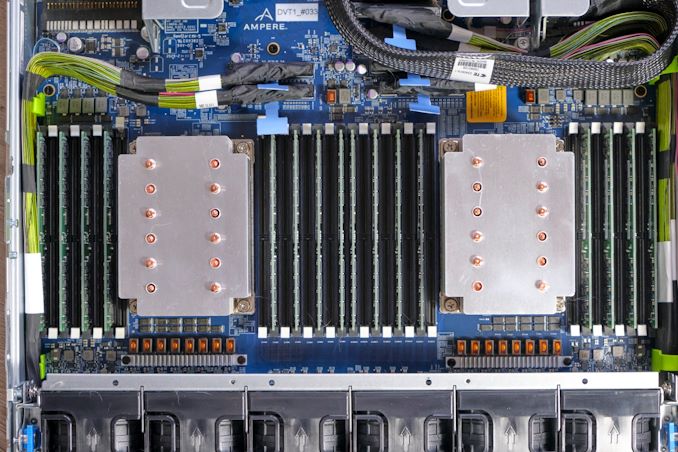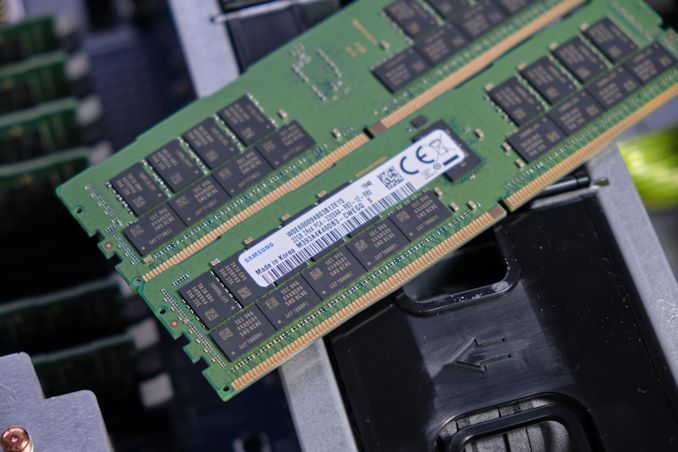The Ampere Altra Review: 2x 80 Cores Arm Server Performance Monster
by Andrei Frumusanu on December 18, 2020 6:00 AM EST- Posted in
- Servers
- Neoverse N1
- Ampere
- Altra
Test Bed and Setup - Compiler Options
For the rest of our performance testing, we’re disclosing the details of the various test setups:
Ampere "Mount Jade" - Dual Altra Q80-33
Obviously, for the Ampere Altra system we’re using the provided Mount Jade server as configured by Ampere.
The system features 2 Altra Q80-33 processors within the Mount Jade DVT motherboard from Ampere.
In terms of memory, we’re using the bundled 16 DIMMs of 32GB of Samsung DDR4-3200 for a total of 512GB, 256GB per socket.
| CPU | 2x Ampere Altra Q80-33 (3.3 GHz, 80c, 32 MB L3, 250W) |
| RAM | 512 GB (16x32 GB) Samsung DDR4-3200 |
| Internal Disks | Samsung MZ-QLB960NE 960GB Samsung MZ-1LB960NE 960GB |
| Motherboard | Mount Jade DVT Reference Motherboard |
| PSU | 2000W (94%) |
The system came preinstalled with CentOS 8 and we continued usage of that OS. It’s to be noted that the server is naturally Arm SBSA compatible and thus you can run any kind of Linux distribution on it.
Ampere makes special note of Oracle’s active support of their variant of Oracle Linux for Altra, which makes sense given that Oracle a few months ago announced adoption of Altra systems for their own cloud-based offerings.
The only other note to make of the system is that the OS is running with 64KB pages rather than the usual 4KB pages – this either can be seen as a testing discrepancy or an advantage on the part of the Arm system given that the next page size step for x86 systems is 2MB – which isn’t feasible for general use-case testing and something deployments would have to decide to explicitly enable.
The system has all relevant security mitigations activated, including SSBS (Speculative Store Bypass Safe) against Spectre variants.
AMD - Dual EPYC 7742
For our AMD system, unfortunately we had hit some issues with our Daytona reference server motherboard, and moved over to a test-bench setup on a SuperMicro H11DSI0.
We’re also equipping the system with 256GB per socket of 8-channel/DIMM DDR4-3200 memory, matching the Altra system.
| CPU | 2x AMD EPYC 7742 (2.25-3.4 GHz, 64c, 256 MB L3, 225W) |
| RAM | 512 GB (16x32 GB) Micron DDR4-3200 |
| Internal Disks | OCZ Vector 512GB |
| Motherboard | SuperMicro H11DSI0 |
| PSU | EVGA 1600 T2 (1600W) |
As an operating system we’re using Ubuntu 20.10 with no further optimisations. In terms of BIOS settings we’re using complete defaults, including retaining the default 225W TDP of the EPYC 7742’s, as well as leaving further CPU configurables to auto, except of NPS settings where it’s we explicitly state the configuration in the results.
The system has all relevant security mitigations activated against speculative store bypass and Spectre variants.
Intel - Dual Xeon Platinum 8280
For the Intel system we’re also using a test-bench setup with the same SSD and OS image actually – we didn’t have enough RAM to run both systems concurrently.
Because the Xeons only have 6-channel memory, their maximum capacity is limited to 384GB of the same Micron memory, running at a default 2933MHz to remain in-spec with the processor’s capabilities.
| CPU | 2x Intel Xeon Platinum 8280 (2.7-4.0 GHz, 28c, 38.5MB L3, 205W) |
| RAM | 384 GB (12x32 GB) Micron DDR4-3200 (Running at 2933MHz) |
| Internal Disks | OCZ Vector 512GB |
| Motherboard | ASRock EP2C621D12 WS |
| PSU | EVGA 1600 T2 (1600W) |
The Xeon system was similarly run on BIOS defaults on an ASRock EP2C621D12 WS with the latest firmware available.
The system has all relevant security mitigations activated against the various vulnerabilities.
Compiler Setup
For compiled tests, we’re using the release version of GCC 10.2. The toolchain was compiled from scratch on both the x86 systems as well as the Altra system. We’re using shared binaries with the system’s libc libraries.












148 Comments
View All Comments
Wilco1 - Monday, December 21, 2020 - link
Why would they introduce Graviton if it would run at a loss??? A significant percentage of AWS is already Graviton (probably 20% by now). If anything Graviton increases profitability due to vertical integration and other cost reduction.mode_13h - Monday, December 21, 2020 - link
First, there's a fundamental disparity between an in-house CPU and a 3rd Party one, where Amazon can cut out some overheads by building their own. So, that already skews the price-comparison.The other question is whether Amazon is partially-subsidizing the price of their Graviton2 instances as an incentive to get more people to switch. For a business, the least risky thing is to stay on x86, so Amazon needs to present an immediate and significant cost savings to get people to switch. After they've switched and ARM server cores have had more time to mature, Amazon can charge more and make back a good return on investment.
I obviously don't know if that's what they're doing, but we don't know that it's not. So, you really can't read much into their current pricing. That's all I'm saying.
mode_13h - Sunday, December 20, 2020 - link
Finally, I guess you missed this part, in the discussion of SPECjbb:> One thing that did come to mind immediately when I saw the results was SMT.
> Due to this being a transactional data-plane resident type of workload,
> SMT will undoubtedly help a lot in terms of performance,
> so I tested out the EPYC chip figures with SMT disabled,
> and indeed max-jOPS went down to 209.5k for the 2S THP enabled results,
> meaning that SMT accounts for a 29.7% performance benefit in this benchmark.
...
> It’s generally these kinds of workloads that SMT works best on,
> and that’s why IBM can deploy SMT4 or SMT8 processors,
> and the type of workloads Marvell’s ThunderX was trying to carve a niche or itself with SMT4.
mode_13h - Sunday, December 20, 2020 - link
As the article mentions, Marvell’s ThunderX did support SMT on ARMv8-A.Were SMT's reputation not bruised by all the recent side-channel exploits, perhaps it would be showing up in some of ARM's own cores. Maybe their V-series will get it, since that's a much larger core.
Wilco1 - Monday, December 21, 2020 - link
ThunderX2/X3 and Neoverse E1 have SMT, but neither has been hugely successful. SMT doesn't provide a significant benefit across a wide range of workloads, so adding another core remains simpler and cheaper. And yes, security is another nail in the coffin.EthiaW - Saturday, December 19, 2020 - link
The performance of Graviton2 meets our expectation for Neoverse N1 (or Cortex A76) better. How can Q80 manage to deliver so much higher IPC with the same architecture? Incredible.Brutalizer - Saturday, December 19, 2020 - link
One old Oracle SPARC T8 cpu does 153.500 Java max-JOPS SPECjbb2015. And the crit-JOPS value is 90.000. Easily smashing all cpus here.https://blogs.oracle.com/bestperf/specjbb2015:-spa...
satai - Saturday, December 19, 2020 - link
Benchmarked by Oracle... Definitely trustworthy.zepi - Saturday, December 19, 2020 - link
SPECJBB graphs kill me.For the love of god, please keep the axis scaling identical!
Same applies to every single metric always. If you provide separate graphs for different products, please make sure that axis-scaling is the same in all images!
Andrei Frumusanu - Sunday, December 20, 2020 - link
The graphs are generated by the benchmark itself.